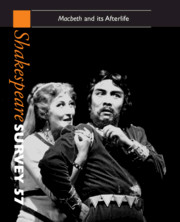Book contents
- Frontmatter
- Humane Statute and the Gentle Weal: Historical Reading and Historical Allegory
- Macbeth’s Knowledge
- ‘The Grace of Grace’ and Double-Talk in Macbeth
- Remind Me: How Many Children Had Lady Macbeth?
- Taking Macbeth out of Himself: Davenant, Garrick, Schiller and Verdi
- ‘Two truths are told’: Afterlives and Histories of Macbeths
- Doing All That Becomes a Man: The Reception and Afterlife of the Macbeth Actor, 1744–1889
- Macbeth and Kierkegaard
- Monsieur Macbeth: from Jarry to Ionesco
- The Politics of Sleepwalking: American Lady Macbeths
- Macbird! and Macbeth: Topicality and Imitation in Barbara Garson’s Satirical Pastiche
- Mick Jagger Macbeth
- ‘The Zulu Macbeth’: The Value of an ‘African Shakespeare’
- ‘A Drum, a Drum – Macbeth doth come’: When Birnam Wood moved to China
- The Banquet of Scotland (PA)
- Scoff power in Love’s Labour’s Lost and the Inns of Court: Language in Context
- Mercury, Boy Yet and the ‘Harsh’ Words of Love’s Labour’s Lost
- Shakespeare, Sir Thomas More and Asylum Seekers
- Hal as Self-Styled Redeemer: The Harrowing of Hell and Henry IV Part 1
- Mr Hamlet of Broadway
- Shakespeare Performances in England, 2003
- Professional Shakespeare Productions in the British Isles January–December 2002
- The Year's Contributions to Shakespearian Study 1 Critical Studies
- 2 Shakespeare in Performance
- 3 Editions and Textual Studies
- Books Received
- Index
Remind Me: How Many Children Had Lady Macbeth?
Published online by Cambridge University Press: 28 March 2007
- Frontmatter
- Humane Statute and the Gentle Weal: Historical Reading and Historical Allegory
- Macbeth’s Knowledge
- ‘The Grace of Grace’ and Double-Talk in Macbeth
- Remind Me: How Many Children Had Lady Macbeth?
- Taking Macbeth out of Himself: Davenant, Garrick, Schiller and Verdi
- ‘Two truths are told’: Afterlives and Histories of Macbeths
- Doing All That Becomes a Man: The Reception and Afterlife of the Macbeth Actor, 1744–1889
- Macbeth and Kierkegaard
- Monsieur Macbeth: from Jarry to Ionesco
- The Politics of Sleepwalking: American Lady Macbeths
- Macbird! and Macbeth: Topicality and Imitation in Barbara Garson’s Satirical Pastiche
- Mick Jagger Macbeth
- ‘The Zulu Macbeth’: The Value of an ‘African Shakespeare’
- ‘A Drum, a Drum – Macbeth doth come’: When Birnam Wood moved to China
- The Banquet of Scotland (PA)
- Scoff power in Love’s Labour’s Lost and the Inns of Court: Language in Context
- Mercury, Boy Yet and the ‘Harsh’ Words of Love’s Labour’s Lost
- Shakespeare, Sir Thomas More and Asylum Seekers
- Hal as Self-Styled Redeemer: The Harrowing of Hell and Henry IV Part 1
- Mr Hamlet of Broadway
- Shakespeare Performances in England, 2003
- Professional Shakespeare Productions in the British Isles January–December 2002
- The Year's Contributions to Shakespearian Study 1 Critical Studies
- 2 Shakespeare in Performance
- 3 Editions and Textual Studies
- Books Received
- Index
Summary
When L. C. Knights, prepped by F. R. Leavis, innocently dropped his question on an unsuspecting audience at a meeting of the Shakespeare Association in 1932, ‘How Many Children Had Lady Macbeth?’, he didn’t expect an answer. He expected a revolution. Comically self-deprecating, thirty years later he recalled the occasion, remembering himself as ‘a comparatively young man, dissatisfied with the prevailing academic approach to Shakespeare’, specifically, Bradley-ite ‘character’ criticism, the kind of criticism that observed the discrepancy between Lady Macbeth’s Act 1 assertion, ‘I have given suck and know / How tender ’tis to love the babe that milks me’(1.7.54–5), Macbeth’s traumatized meditation on his childlessness in Act 3 (3.1.60–73), and Macduff’s desolate cry in Act 4, ‘He has no children’(4.3.217) and, worried by apparent inconsistencies, tried to account for the Macbeths’ missing babies. Impatient with Bradley and his acolytes, Knights was ‘excited by the glimpses I had obtained of new and it seemed more rewarding approaches’ – modernist criticism, a criticism framed by Eliot and Wilson Knight that read Shakespeare’s plays as dramatic poems, ‘imaginative constructions mediated through the poetry’, a criticism that found useful analogies with music, looking for leitmotivs and themes rather than motives and character-development, attempting to account for the complex structures of Shakespeare’s verse and to find the plays’ meanings in what Wilson Knight termed ‘the logic of imaginative correspondence’ rather than the ‘logic of plot’. For young Lionel Knights this was bracing stuff.
- Type
- Chapter
- Information
- Shakespeare SurveyAn Annual Survey of Shakespeare Studies and Production, pp. 38 - 53Publisher: Cambridge University PressPrint publication year: 2004
- 3
- Cited by



